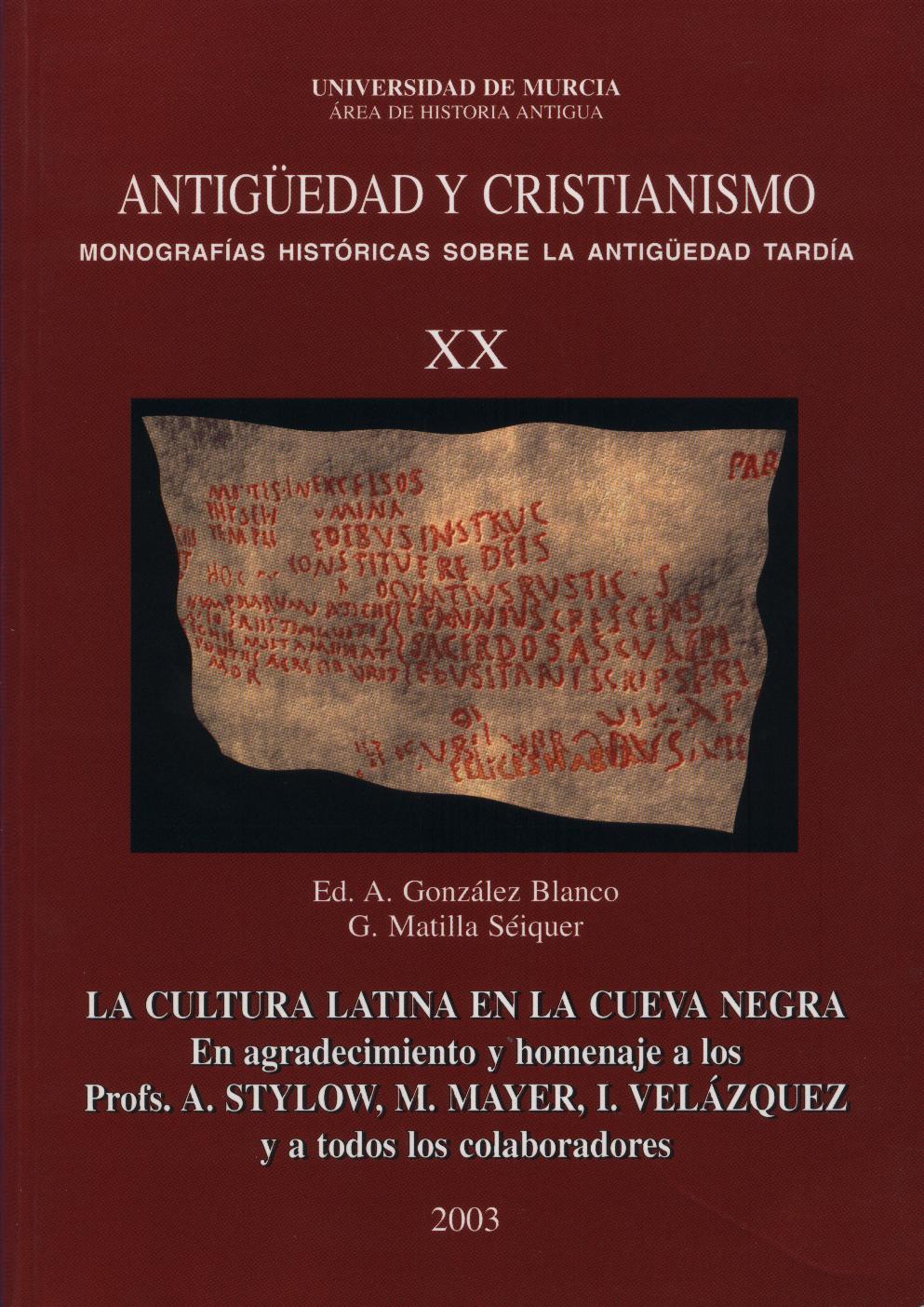Símbolos y rituales en las inscripciones de la Cueva Negra de Fortuna (Murcia): correlaciones entre etnolingüística y etnohistoria
Abstract
Cultural anthropological elements in the Cueva Negra in Fortuna.1. Gnostic and Soteriological elements in the Cueva Negra: the processio ad fontes, the epiphania Esculapii, the puerperal water, the bathing of the new borns. The harvesting, the lavacrum, the placatio, the health, happiness and the entry into the inner being. The «gnostic scale» and the ritual and sacrifi cial icons.2. The decline of the religiousness of the pateres hosioi. The return of the spêlaitai and the theandroi. The god of the multiple epinoiai.3. The transformation of the local religion without the uprooting of the local identity: the epifania de Koré according to the epifaniy and its rebirth rites of Aion. The procession of Salambó and the restauratio imaginis in the neo-Punic rituals in Sevilla in the third century (Passio of the Saints Justina and Rufi na).4. Scripture as the supreme Cult act, as a liturgical activity en the soteria kata gnosin. The exvoto tablets with scripture, the prayers written on tablets, the verses on small boxes, used as charms, the scriptures on stones as monumentum.
Downloads
References
CARDONA, G.R., Antropología de la escritura, Gedisa Barcelona 1999, pp. 147 ss.
MARQUÈS RIVIÈRE, J., Amulettes, talismans et pantacles dans les traditions orientales et occidentales, Payot Paris 1972 (2ª ed.).
BERTHOLET, A., Die Macht der Schrift, Ak. Wiss. Phil.-historis. Kl. Berlín, 1948.
DODDS, E.R., I Greci e l’irrazionale, tr. it. Florencia 1959, pp. 335-370.
EITREM, S., «La théologie chez les Néoplatoniciens et dans les Papyrus magiques»,en Sym-bolae Osloenses 1942.
FÉSTUGIERE, A.-J., La Révelation d’Hermès Trismégiste, vol. I, Paris 1950.
FERNÁNDEZ ARDANAZ, S., «Antropología de los primeros autores hispanos (s. IV)», en vol. I de Historia de la Teología Española, F.U.E. Madrid 1983, pp. 20-366.
FERNÁNDEZ ARDANAZ, S., Génesis-anagénnesis: paradigmas en la antropología medite-rránea, ESET Vitoria 1990, p. III, pp. 165-212.
FERNÁNDEZ ARDANAZ, S., El Mito del ‘hombre nuevo’: los paradigmas antropológicos en el diálogo cristianismo-helenismo del s. II, F.U.E. Madrid 1991; ver especialmente Simbología y modelos antropológicos en el s. II d. C., pp. 193-225
.FERNÁNDEZ ARDANAZ, S., «La diffusione del cristianesimo nel nord-ovest della penisola Iberica: questioni sociali e antropologiche», en XXXIX Corso di cultura sull’arte ravennate e bizantino, Ravenna 1992, pp. 301-320
.FERNÁNDEZ ARDANAZ, S., «Cristianizzazione e cambiamenti sociali nelle culture montane del nord dell’Hispania», en Cristianesimo e specifi cità nel Mediterraneo Latino, Eph. Au-gustinianae, Roma 1994, pp. 483-512.
FERNÁNDEZ ARDANAZ, S., «La cuestión de la supervivencia del mundo púnico en el Medi-terráneo occidental», en El mundo púnico. Historia, sociedad, cultura, Public. Univ. Murcia 1994, pp. 97-114.
FERNANDEZ ARDANAZ, S., «Risus Paschalis y Risa Ritual Mistérica: La risa festiva en las Vel.les Serrats y en los Ritos de la Vigilia Pascual en la zona baja del Segura». Congreso de Religiosidad Popular. Fundación Machado. Andujar 1998.
FERNÁNDEZ ARDANAZ, S., «Santuarios de Cuevas y Santerón: Rituales Festivos de Identidad y Alianza. Expresión de Antiguas Federaciones Prerromanas». EnAntropología de la Fiesta, vol. I: Identidad, Mercado y Poder,Inst. Gil Albert Alicante 1999, pp. 109-131.
FERNÁNDEZ ARDANAZ, S., «Cuestiones histórico-antropológicas en las tensiones actuales del Magreb». I Congreso Internacional de «Antropología del Mediterráneo». Los Alcázares 2000, pp. 217-227.
FERNÁNDEZ ARDANAZ, S., «Los Auroros de Callosa del Segura». II Jornadas de Antro-pología de las Fiestas: «Peñas, charangas, cofradías, collas y comparsas», Alicante-Elche 2000, pp. 329-342.
FERNÁNDEZ ARDANAZ, S., «Els Enfarinats de Ibi». En II Jornadas de antropología de las Fiestas, «Peñas, charangas, cofradías, collas y comparsas, Elche 2000, pp. 343-360.
FERNÁNDEZ ARDANAZ, S., «Peñas festivas, cofradías, federaciones precristianas en Santerón (Cuenca-Ademuz): un proceso de refuncionalización». En Antropología de la Fiesta, vol. II,Inst. Gil-Albert Alicante 2000, pp. 69-87.
FERNÁNDEZ ARDANAZ, S., «Les Dances del Rei Moro de Agost: símbolos y rituales», en III Jornadas de la Fiesta, Inst. Gil-Albet, Alicante-Elche 2001, pp. 275-288.
FERNÁNDEZ ARDANAZ, S., «El Corpus Christi en la Rioja Alavesa: simbología de las más-caras y sus danzas rituales en la «fi esta de las fi estas del año», En III Jornadas nacionales de Antropología de la Fiesta, Elche-Alicante 2001, pp. 79-95.
FERNÁNDEZ ARDANAZ, S., «Enculturación en el mundo neopúnico: traducción de la Biblia al neopúnico», II Congreso Internacional de Mundo Púnico: Religión, Antropología y Cultura Material, Cartagena 6-9 abril del 2000, Murcia, Universidad 2004, pp. 409-413.
PICCALUGA, G., Elementi spettacolari nei rituali festivi romani, Ed. dell’Ateneo, Roma 1965.
PICCALUGA, G. (1974), Aspetti e problemi della religione romana, Florencia 1974.
1. The authors non-exclusively assign the exploitation rights (reproduction, distribution, communication and transformation) to the magazine.
2. The works published in this magazine are subject to the Attribution-ShareAlike 4.0 International license (CC By SA 4.0). Therefore, they can be copied, used, disseminated, transmitted and publicly displayed, provided that:
i) the authorship and the original source of its publication (journal, editorial and URL of the work) are cited, thus allowing its recognition.
ii) it is allowed to remix, transform or create from the material while maintaining the same license as the original.
Note: Articles prior to 2022 incorrectly display the CC by SA license in the abstract page. They are under a CC by NC ND license as embedded in the article pdfs. Articles published in 2022 and after are under the CC by SA license.

3. Self-archiving conditions. Authors are allowed and encouraged to electronically disseminate the pre-print (version before being evaluated) and/or post-print (version evaluated and accepted for publication) versions of their works before publication, as it favors their publication. Earlier circulation and diffusion and with it a possible increase in its citation and reach among the academic community. Color RoMEO: verde.























